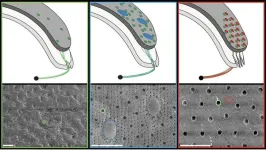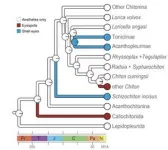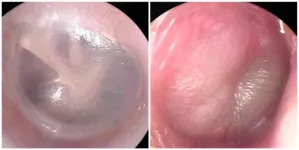(Press-News.org) (Santa Barbara, Calif.) — You’d probably walk past a chiton without even seeing it. These creatures often look like nothing more than another speck of seaweed on the crusty intertidal rocks. But it sees you. At least, if it’s one of the species with eyes dotting its platemail shell.
A team of scientists — led by Rebecca Varney at UC Santa Barbara’s Department of Ecology, Evolution, and Marine Biology (EEMB) — discovered that some of these tough mollusks sport the most recently evolved eyes with a lens. What’s more, the two kinds of eyes found in this group arose in four separate events. The researchers lay out what factors led to this peculiar arrangement in a paper published in the journal Science.
Chitons are a curious group of marine mollusks. Though generally out of the public eye, they’ve made headlines for some remarkable feats. For instance, all species coat their teeth in the iron mineral magnetite, making them the hardest material created by a living organism. And at least one species uses the aptly named santabarbaraite, another iron mineral.
Despite chitons’ relation to squid, snails and scallops, their eyes aren’t located on their soft bodies. Instead, many of their sensory organs are embedded directly into their segmented shell. “I don't think there's any other animal that builds its eyes into its armor like a chiton does,” said co-author Daniel Speiser of the University of South Carolina. The most numerous of these organs are called aesthetes, small sensory structures found in the outermost layer of the shells of all chitons. Scientists are still investigating their function, but if they do detect light, it would be on a very rudimentary level.
Aesthetes likely served as the basis for the two kinds of eyes that did evolve in some of these animals: the more complex shell eyes and the more numerous eyespots. Shell eyes are relatively large, and similar to human eyes, they have a lens that focuses incoming light to form an image on a photosensitive layer at the back. That said, in chitons this lens is formed of the mineral aragonite. In contrast, the smaller eyespots in certain chitons function more like individual pixels, or the compound eye of an insect, forming a visual sensor distributed over the chiton’s shell. Chitons add these structures in new growth at the shell margin.
Senior author Todd Oakley studies how complex systems evolve, and has used chiton eyes as an example in his classes as a Professor in EEMB. Co-author Speiser worked on chitons as part of his doctoral thesis before joining Oakley’s lab as a postdoctoral researcher.
“We wanted to know: Is there something that we can identify that is guiding evolution in these different groups toward eyespots or toward shell eyes?” said lead author Varney, one of Oakley’s current postdocs.
To get started, the team began constructing a chiton family tree using DNA from specimens preserved in co-author Doug Eernisse’s global chiton collection, which now resides at the Santa Barbara Museum of Natural History. Co-authors Johanna Cannon and Morris Aguilar developed the molecular tools to probe the chiton genomes. Varney then mapped out which groups had eyespots and which had shell eyes, which yielded quite the surprise.
What the team had thought were two groups that each developed a different visual system ended up being four groups, with two pairs converging on the same structure. “We went in knowing there were two types of eyes, so we were not expecting four independent origins,” Varney said. “The fact that chitons evolved eyes four times, in two different ways, is pretty amazing to me.”
“It almost seemed too strange to be true,” added Oakley. And the groups that arrived at similar structures weren’t even the ones most closely related to each other. So what could’ve led to this curious setup?
Varney began poring over the differences between species in these groups to see if she could spot any clue as to what sent them toward different solutions to the same task. Fortunately for her, the number of slits on the margin of each shell segment is a trait used to distinguish different species of chitons. So this information is well documented, because it’s included in every new species description.
Without context, this doesn’t mean much, but a pattern began to emerge. Varney noticed that chitons with eyespots have a lot of slits — some upward of 20 notches in their head section. In contrast, chitons that evolved the larger shell eyes generally had about eight slits on this section. But again, how could this variation have sent the groups toward radically different adaptations, not once, but twice?
These notches serve as the conduit for nerves to pass from the chiton’s shell into its body. So it seems that species with fewer slits evolve fewer, larger shell eyes that are more complex. In contrast, those with more slits were able to develop more numerous, slightly smaller eyespots, which are slightly simpler. And even though the number of notches is diagnostic for the species, scientists don’t know what dictates it. So the number of slits present when visual systems did develop seems to have influenced the type of visual system that evolved.
“Here we have a very clear demonstration in a natural system that evolution depends on what came before, even when what came before might seem completely unrelated,” Oakley said.
The team decided to plumb further, using fossils to calibrate chiton evolution over time. This would give them a better estimate of when the four groups evolved their visual systems after chitons split from other mollusks around 450 million years ago.
They found that the shell eyes of chitons in Toniciinae and Acanthopleurinae are perhaps the most recently evolved lensed eyes, having arisen during the Cretaceous (150 to 100 million years ago). Shell eyes in the unrelated species Schizochiton incisus evolved in the Jurassic (250 to 200 Mya). For context, most other instances of eyes with lenses evolved in the Cambrian, when animals were just beginning to diverge into major groups. Meanwhile, eyespots evolved as early as the Triassic (260 to 200 Mya) in one group, and as late as the Paleogene (75 to 25 Mya) in another.
While some of these chitons have eyes capable of forming images, scientists are still investigating the extent of their visual perception. In a previous paper, Speiser’s team demonstrated that the West Indian fuzzy chiton can resolve objects and respond to them. Their shell eyes send visual information for processing in a ring shaped neural structure that goes around their whole body. The way the optic nerves connect to this ring suggests chitons can locate an object based on the locations of the eyes that spot it. Speiser found that the chitons can resolve objects to an angle of around six degrees. “So while chitons have poor vision compared to our own, it seems like they really do ‘see,’” he said.
This discovery confirms what scientists experience working with these chitons in the field. “When you are collecting chitons off rocks in the intertidal you have to sneak up on the rock. Because if they see you they will clamp down,” Varney said. “And you can sit there with a nail file and try to pry the chiton off; you will lose.”
Speiser and his colleagues are continuing to investigate chiton vision. It’s a bit of a challenge. For one, “a video of a chiton and a picture of a chiton kind of look the same,” Varney quipped. And when it comes to experiments, “chitons don’t really have a reason to cooperate with you, so figuring out how to ask a chiton what it’s looking at is a hard task.”
Members of the team plan to investigate the genetic components of these kinds of eyes and where they came from. This pursuit will require focusing on only one or two species at a time.
We don’t always know what trait will drive the path of evolution. Happenstance changes earlier on can have unexpected consequences in seemingly unrelated systems. “To study evolution as a whole you have to, as much as possible, study these systems as a whole,” Varney said.
END
Unraveling the mystery of chiton visual systems
Researchers uncover surprising origins and complexity behind chiton eyes, shedding light on evolutionary processes
2024-03-04
ELSE PRESS RELEASES FROM THIS DATE:
Case Western Reserve University-led research team discovers new method to test for oral cancer
2024-03-04
CLEVELAND—Oral cancers and precancerous mouth lesions are considered especially difficult to diagnose early and accurately.
For one, biopsies are expensive, invasive, stressful for the patient and can lead to complications. They’re also not feasible if repeated screenings of the same lesion are required.
But a team of researchers, led by a clinician scientist at the Case Western Reserve University School of Dental Medicine, has discovered a noninvasive, low-cost test to detect oral cancer, monitor precancerous lesions and determine when a biopsy is warranted.
Their findings, published ...
Firearm access and gun violence exposure are common in Black and native communities
2024-03-04
A New Jersey Gun Violence Research Center study is the first to provide nationally representative data on gun use, storage and violence within Black and American Indian/Alaskan Native (AIAN) families.
Both Black and native communities have seen increasingly elevated rates of gun violence victimization, including homicide and suicide, according to the Centers for Disease Control and Prevention. In recent years, minorities have become more represented among new firearm owners. Despite this, research on firearm access, storage and use has focused on samples of white adults. This prevents understanding the access Black and native individuals have to firearms, whether they are stored ...
New AI smartphone tool accurately diagnoses ear infections
2024-03-04
A new cellphone app developed by physician-scientists at UPMC and the University of Pittsburgh, which uses artificial intelligence (AI) to accurately diagnose ear infections, or acute otitis media (AOM), could help decrease unnecessary antibiotic use in young children, according to new research published today in JAMA Pediatrics.
AOM is one of the most common childhood infections for which antibiotics are prescribed but can be difficult to discern from other ear conditions without intensive training. The new AI tool, which makes a diagnosis by assessing ...
Screen time and parent-child talk when children are ages 12 to 36 months
2024-03-04
About The Study: This study found a negative association between screen time and measures of parent-child talk when children are 12 to 36 months of age. For every additional minute of screen time, children heard fewer adult words, spoke fewer vocalizations, and engaged in fewer back-and-forth interactions. Interventions aiming to promote early use of language should include support to manage screen time.
Authors: Mary E. Brushe, Ph.D., of the University of Western Australia in Adelaide, South Australia, Australia, is the corresponding author.
To access the embargoed study: Visit our For The Media website at this link https://media.jamanetwork.com/
(doi:10.1001/jamapediatrics.2023.6790)
Editor’s ...
Firearm access and gun violence exposure among American Indian or Alaska native and Black adults
2024-03-04
About The Study: In this nationally representative survey study of 3,542 American Indian or Alaska Native and Black U.S. adults, a substantial percentage of both groups reported living in homes with firearms, storing firearms loaded and unlocked, frequently carrying firearms outside the home, and having been exposed directly and indirectly to gun violence. These findings underscore the need for nuanced public health campaigns and policies and highlight challenges for law enforcement in contexts of racial disparities ...
Associations of medical debt with health status, premature death, and mortality in the US
2024-03-04
About The Study: The findings of this study of 2,943 counties suggest that medical debt is associated with worse health status, more premature deaths, and higher mortality rates at the county level in the U.S. Therefore, policies increasing access to affordable health care, such as expanding health insurance coverage, may improve population health.
Authors: Xuesong Han, Ph.D., of the American Cancer Society in Atlanta, is the corresponding author.
To access the embargoed ...
Low-cost liquid tames tooth decay
2024-03-04
An inexpensive, cavity-fighting liquid called silver diamine fluoride (SDF) works as well as dental sealants to keep tooth decay at bay in a school cavity prevention and treatment program, according to a new study by researchers at NYU College of Dentistry.
The study, which followed more than 4,000 elementary school students for four years and is published in JAMA Pediatrics, shows that SDF is an effective alternative to sealants, and can increase access to dental care while reducing costs.
Dental cavities are the most prevalent ...
More than 1/3 illicit drugs sold on the dark web contain unexpected substances
2024-03-04
Testing of illicit drugs bought online found 35% were not what they said they were, highlighting the urgent need for more local drug testing facilities in Australia to prevent harm and overdose.
The RMIT-led study analysed 103 illicit drug samples sourced from the now-defunct dark web forum Test4Pay in collaboration with the Australian National University, UNSW Sydney and Canadian testing facility Get Your Drugs Tested.
While 65% of samples contained only the advertised substance, the study found 14% of samples had a mixture ...
A better way to deliver fetal therapy for serious genetic disorders
2024-03-04
In a discovery that opens the door to a less invasive way of treating some serious disorders before birth, UC San Francisco scientists have found that delivering medicine through amniotic fluid is as effective as delivering it to the fetal brain via cerebrospinal fluid. The experiment was done in mice with a genetic disorder called Angelman syndrome.
Treating genetic diseases like Angelman in utero could prevent serious symptoms that begin while the fetus is still developing. It’s also easier to access neurons in the fetal brain because the blood-brain barrier that normally acts as a filter ...
Researchers develop amphibian-inspired camouflage skin
2024-03-04
Inspired by amphibians such as the wood frog, investigators designed and synthesized a new type of camouflage skin involving one-dimensional photonic crystal structures assembled in three-dimensional flexible gels.
As described in Advanced Optical Materials, the camouflage skin can quickly recognize and match the background by modulating the optical signals of external stimuli. It demonstrated excellent mechanical performance, self-adaptive camouflage capabilities in response to complex surroundings, and long-term stability in real-world living environments. Bright structural color and mechanical flexibility were maintained even at temperatures as low as -80℃.
The advance ...
LAST 30 PRESS RELEASES:
Trauma or toxic? A deep dive into the impact of stress on kids' health
Turning industrial exhaust into useful materials with a new electrode
ORNL to partner with Type One Energy, UT on world-class facility to validate next-gen fusion
New journal section tackles AI, ethics, and digital health communication
Jeonbuk National University researchers develop novel dual-chemical looping method for efficient ammonia synthesis
New study sheds light on stroke recovery via exercise-induced migration of mitochondria
SEOULTECH researchers develop sodium-based next-generation smart electrochromic windows
Data-driven analysis reveals three archetypes of armed conflicts
Heart disease, stroke deaths down, yet still kill more in US than any other cause
Light switches made of ultra-thin semiconductor layers
Creative talent: has AI knocked humans out?
Sculpting complex, 3D nanostructures with a focused ion beam
A year after undermining Bredt’s rule, UCLA scientists have made cage-shaped, double-bonded molecules that defy expectations
Human activities drive global dryland greening
PeroCycle announces new appointments as it builds a world-class board for meaningful climate impact
Magnetic avalanches power solar flares
LeapSpace goes live: the Research-Grade AI-Assisted Workspace built on trusted science
DNA tests reveal mysterious beluga family trees
Strategic sex: Alaska’s beluga whales swap mates for long-term survival
How early cell membranes may have shaped the origins of life
Cannabis legalization is driving increases in marijuana use among U.S. adults with historically lower consumption rates
Multifunctional dipoles enabling enhanced ionic and electronic transport for high‑energy batteries
Triboelectric nanogenerators for future space missions
Advancing energy development with MBene: Chemical mechanism, AI, and applications in energy storage and harvesting
Heteroatom‑coordinated Fe–N4 catalysts for enhanced oxygen reduction in alkaline seawater zinc‑air batteries
Meta-device for precision lateral displacement sensing
Plasma-guided mitotane for the treatment of adrenocortical carcinoma: adjuvant care to advanced disease
Theoretical study of laser-enhanced nuclear fusion reactions
Social environment impacts sleep quality
Optimized kinetic pathways of active hydrogen generation at Cu2O/Cu heterojunction interfaces to enhance nitrate electroreduction to ammonia
[Press-News.org] Unraveling the mystery of chiton visual systemsResearchers uncover surprising origins and complexity behind chiton eyes, shedding light on evolutionary processes




